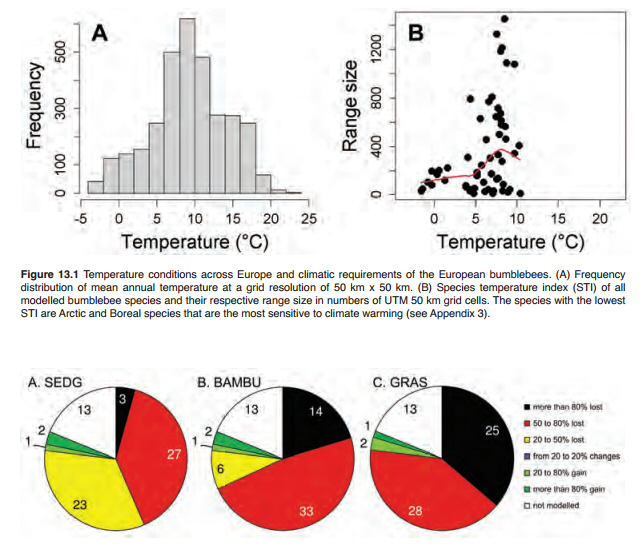Bee numbers have rebounded nicely but the report says they are not out of the woods yet.
According to the background information in the Status and Trends of European Pollinators (STEP) report, pollination is helps 84% of European crops on some ecosystem level and 78% of temperate wildflowers needing biotic pollination. The authors also estimate that ~10% of the total economic value of European agricultural output for human food amounted to €22 billion in 2005 (€14.2 for the EU) was dependent upon insect pollination.

Severity of projected changes in 2100 for the 69 studied European bumblebee species. For 21 species we assumed full dispersal, for the remaining no dispersal (see Appendix 3). Thirteen species have not been assessed. Dark green background indicates a large expansion (more than 80% gain in suitable area); light green indicate expansion (between 20 and 80% gain in suitable area); yellow background indicates regression (between 20 and 50% loss of suitable area); red background indicates strong regression (from 50 to 80% loss of suitable area); dark background indicates very strong regression with extinction risk (more than 80% loss of suitable area). A. SEDGE scenario; B. BAMBU scenario; C. GRAS scenario.
Though bee numbers have been on an upward trend overall since accurate records came into existence in the 1960s, in one region of Europe, bees did decline and the authors contend it is a 'cocktail' of environmental stressors which could threaten the entire EU in the future. They further believe that nature-based solutions are possible.
The cause is due to climate change, they write in "Climatic Risk and Distribution Atlas of European Bumblebees". The atlas provides what they believe is the most comprehensive evaluation of the likely consequences this will have.
To make their estimate, the authors from universities and environmental NGOs collated over one million bumblebee records provided from all over Europe. Based on these data, they modeled the current climatic niche for almost all European species (56 species) and projected future climatically suitable conditions using three climate change scenarios for the years 2050 and 2100.
While under a moderate change scenario only two species are projected to be at the verge of extinction by 2100, 14 species are at particularly high risk under an intermediate change scenario. Under a more severe change scenario as many as 25 species are projected to lose almost all of their climatically suitable area.
Strong mitigation strategies are therefore needed to preserve this important species group and to ensure the sustainable provision of pollination services, to which they considerably contribute.
Professor Simon Potts of the University of Reading, Coordinator of STEP, said, "Europe's pollinators face many challenges if they are to continue to support food production and maintain the flower diversity of our landscapes. The STEP project has generated a substantial body of knowledge on how to conserve pollinators, safeguard the pollination of crops and better understand how mitigate against threats".
Citation: Rasmont P, Franzén M, Lecocq T, Harpke A, Roberts S, Biesmeijer K, Castro L, Cederberg B, Dvorak L, Fitzpatrick Ú, Gonseth Y, Haubruge E, Mahé G, Manino A, Michez D, Neumayer J, &Ostroke;degaard F, Paukkunen J, Pawlikowski T, Potts S, Reemer M, Settele J, Straka J, Schweiger O (2015) Climatic Risk and Distribution Atlas of European Bumblebees. BioRisk 10: 1-236. doi: 10.3897/biorisk.10.4749




Comments